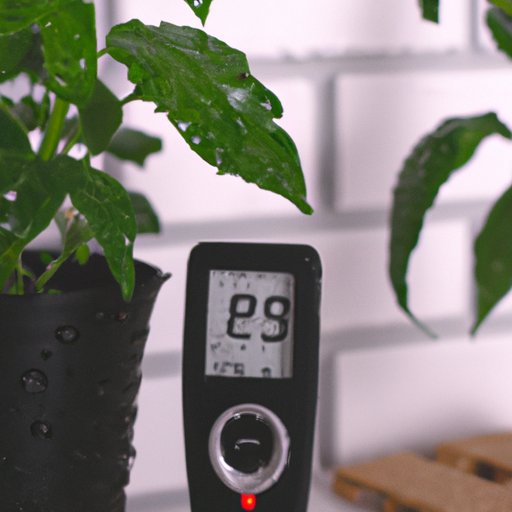Introduction
Watering your indoor plants is one of the most important tasks for keeping them healthy and happy. Without proper hydration, plants can become stressed, weakened, or even die. So, it’s essential to develop a watering routine that works for your lifestyle and meets the needs of your plants.
In this article, we’ll explore how to water indoor plants properly. We’ll discuss the importance of developing a watering schedule, monitoring soil moisture levels, using different types of pots, installing an irrigation system, utilizing self-watering systems, and considering rainwater as an option.

Develop a Watering Schedule for Your Indoor Plants
The first step in learning how to water indoor plants is to create a schedule. This will help you keep track of when and how often to water your plants. The frequency of watering will depend on the type of plant and its individual needs. You should also factor in things like the size of the pot, the amount of sun exposure, and the temperature of the room.
Do some research to determine how often each type of plant needs to be watered. For example, succulents may need to be watered every two weeks, while ferns require more frequent watering. Once you know the needs of each plant, create a schedule that fits into your lifestyle. Mark it down in your calendar so you don’t forget.
Monitor the Moisture Levels of Your Soil
It’s also important to monitor the moisture levels of your soil. Overwatering can be just as harmful as underwatering. You can purchase a moisture meter to check the soil regularly and determine when it needs to be watered. This will help you avoid overwatering and ensure your plants are getting enough hydration.

Use Different Types of Pots to Suit Different Needs
The type of pot you use can make a big difference in how often you need to water your plants. Consider the size, shape, and material of the pot. Larger pots retain more moisture and require less frequent watering than smaller pots. Clay pots are porous and allow water to evaporate quickly, while plastic pots hold in moisture for longer periods of time.
Choose the right pot to fit the needs of your plants. If you have a plant that requires more frequent watering, opt for a smaller pot with a plastic liner. For plants that need less frequent watering, choose a larger clay pot.
Install an Irrigation System for Frequent and Efficient Watering
If you’re looking for a more efficient way to water your indoor plants, consider installing an irrigation system. There are several types of irrigation systems available, such as drip irrigation, sprinkler systems, and automated systems. Each type has its own advantages and disadvantages, so do some research to find the best solution for your needs.
If you decide to install an irrigation system, make sure to follow the instructions carefully. You’ll need to dig trenches for the pipes, attach the water source, and connect the pipes to the plants. It’s also important to set up a timer so the system turns on and off at the appropriate times.
Utilize Self-Watering Systems for Easy Maintenance
Self-watering systems are becoming increasingly popular among indoor gardeners. These systems use wicks, pumps, and reservoirs to provide consistent hydration to your plants. The wick transports water from the reservoir to the soil, while the pump helps to regulate the flow of water. The result is a convenient and low-maintenance solution for watering indoor plants.
Self-watering systems are great for busy gardeners who don’t have the time to manually water their plants. They also reduce the risk of overwatering and help to keep the soil moist and aerated. However, they can be expensive to install and require regular maintenance.
Consider Using Rainwater for Your Plants
Rainwater is an excellent source of hydration for your plants. It’s free, pure, and contains fewer chemicals and minerals than tap water. Plus, it’s better for the environment since it doesn’t rely on energy-intensive processes like filtration and chlorination.
To collect rainwater, you’ll need to invest in a rain barrel or rain tank. Place the barrel or tank in an area where it can easily collect rainwater, such as a rooftop or under a gutter. Make sure to cover the container to keep out debris and pests. Once the rainwater has been collected, you can use it to water your plants.

Research the Specific Needs of Each Type of Plant
Finally, it’s important to research the specific needs of each type of plant. Every plant is different and requires different amounts of water and nutrients. Knowing the specific needs of your plants will help you create a watering schedule that meets their individual needs.
There are plenty of resources available to help you research the needs of your plants. You can consult books, websites, and gardening forums for information about watering schedules, soil types, and other important factors.
Conclusion
Watering your indoor plants is essential for keeping them healthy and happy. In this article, we discussed how to water indoor plants properly, including developing a watering schedule, monitoring soil moisture levels, using different types of pots, installing an irrigation system, utilizing self-watering systems, and considering rainwater as an option.
We hope this article has provided you with the information you need to properly water your indoor plants. Remember to research the specific needs of each type of plant and create a watering schedule that works for your lifestyle. With a little bit of effort, you can ensure your plants get the hydration they need to thrive.


